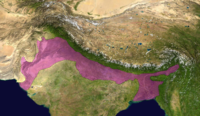
Photo from wikipedia
The early Cenozoic topography of the northern Tibetan plateau remains enigmatic because of the paucity of independent paleoelevation constraints. Long‐held views of northward propagating deformation imply a low Paleogene elevation,… Click to show full abstract
The early Cenozoic topography of the northern Tibetan plateau remains enigmatic because of the paucity of independent paleoelevation constraints. Long‐held views of northward propagating deformation imply a low Paleogene elevation, but this prediction is speculative. We apply flexural modeling to reconstructed Paleogene isopach data obtained from the Qaidam basin, which requires a larger topographic load in the Qilian Shan and a smaller load in the Eastern Kunlun Shan. Incorporating knowledge of proto‐Paratethys marine incursions in the Paleogene Qaidam basin, we infer a topographically low (0.4–1.0 km) Eastern Kunlun Shan and a higher (0.4–1.5 km) Qilian Shan during the Paleogene. This implied paleo‐relief contrasts with previous predictions and suggests more recently, Neogene surface uplift in the Eastern Kunlun Shan has been more significant than in Qilian Shan, highlighting diachronous growth of the northern Tibetan plateau. The low‐moderate paleoelevation implies a warmer and more humid climate in Northern Tibet during the Paleogene.
Journal Title: Geophysical Research Letters
Year Published: 2021
Link to full text (if available)
Share on Social Media: Sign Up to like & get
recommendations!